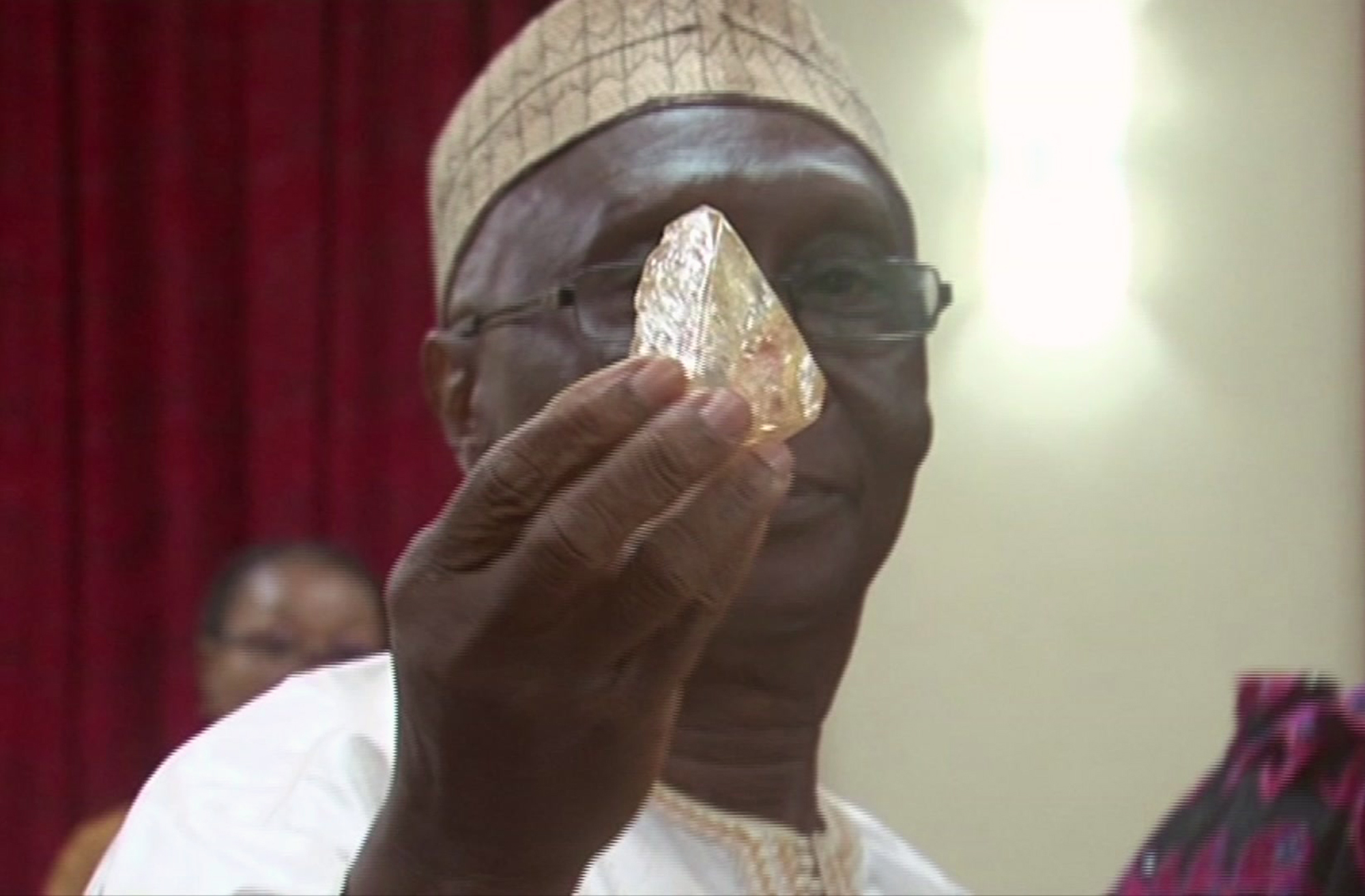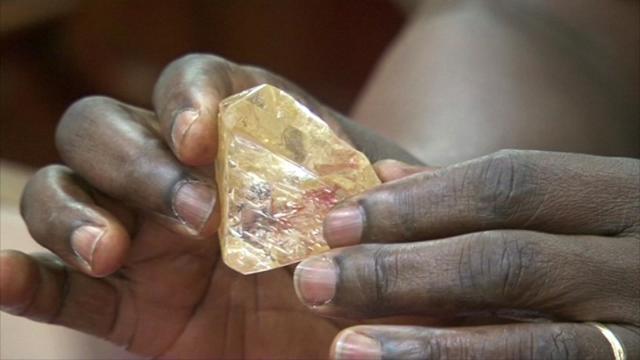A pastor and independent miner in Sierra Leone has unearthed an uncut 706-carat diamond estimated to be worth tens of millions of dollars. The pastor turned the diamond over to the government in hopes that the proceeds from its sale will help the impoverished country. But given the history of this former “blood-diamond” nation, what happens from here is anyone’s guess.
Image: AP
Discovered by artisanal miner Leone Emmanuel Momoh in the diamond-rich Kono region, it’s the largest uncut diamond found in Sierra Leone in more than four decades, and the second largest diamond ever found in the country, according to a report by the Associated Press. In 1972, a 968.9-carat diamond was found in Sierra Leone that eventually sold for $US2.5 million ($3.2 million). The value of the new alluvial diamond, rated at 706-carats, has not yet been determined, but it will likely fetch tens of millions of dollars at auction.

Sierra Leone’s Minister of Mines and Mineral Resources Alhaji Minkailu Mansaray holds the diamond during a meeting with delegates of Kono district, where the gem was found. (Image: AP)
Momoh, who is one of thousands of workers who pan for gems, handed the diamond over to a local chief, who in turn gave it to President Bai Koroma on Momoh’s behalf. The pastor said he gave the diamond to the government in hopes the proceeds will be used to fund ongoing infrastructure improvements in the impoverished Kono District. The government plans to auction the diamond, and take a four per cent cut. Momoh himself is entitled to the lion’s share of the proceeds, but it’s not clear what he plans to do with the money.
President Koroma thanked the chief for his actions, and for not smuggling the diamond out of the country. He described the diamond as “a gift from God”, saying, “it will be a terrible thing if anyone tries to do something criminal with it.”
The precious gem is now in Freetown’s central bank vault awaiting valuation under the Kimberley Process, which certifies diamonds as being “conflict-free”. This initiative, introduced by the World Diamond Congress at Antwerp in 2000, is an effort to stem the flow of conflict diamonds used by rebel movements to finance wars against legitimate governments. In Sierra Leone, these so-called “blood diamonds” fuelled a decade-long civil war in which rebels forced civilians to mine the precious stones, and purchased weapons with the proceeds.
Unfortunately, the Kimberly Process doesn’t appear to be working, or at least not as well as hoped. There’s no guarantee that diamonds certified by the Kimberley Process are actually conflict-free, due to the ongoing presence of corrupt government officials in many of the countries involved. In some cases, officials accept bribes in exchange for the Kimberley Process certification.
Even if the new diamond gets the Kimberley Process stamp of approval, the citizens of Sierra Leone are already sceptical they will benefit from the sale. “Previous diamonds have not benefited the people and I wonder how this new diamond will make a difference,” noted Jeneba Kallon, a civil servant, in Deutsche Welle.
It’s easy to be cynical about the situation, and the fate of the proceeds gleaned from the diamond, but there may be reason for optimism. President Koroma, who is now serving his second democratically elected term, isn’t the worst leader in the world. He has led an anti-corruption campaign, opened the country to foreign investors, and has worked to rebuild the nation’s infrastructure following the civil war that ended in 2002. As for the country’s many government officials and bureaucrats, their potential actions are less clear. According to a 2013 report by Transparency International’s Global Corruption Barometer, Sierra Leone has the highest incidence of bribery in sub-Saharan Africa.
As to what happens now, President Koroma has given instructions to the Ministry of Mines stating that “the evaluation, sale, and distribution of the proceeds must be done in the most transparent manner”. We’ll just have to wait and see.
[referenced url=”https://gizmodo.com.au/2015/11/miners-just-unearthed-this-huge-diamondthe-largest-to-be-found-in-100-years/” thumb=”https://i.kinja-img.com/gawker-media/image/upload/t_ku-large/1525726592881126948.jpg” title=”Miners Just Unearthed This Huge Diamond — The Largest To Be Found In 100 Years” excerpt=”Imagine putting this thing on a ring. You’re looking at the biggest diamond to be found in the last 100 years, which was discovered in a mine in north-central Botswana.”]
As for other notable diamond discoveries, the Cullinan Diamond is the largest ever found, clocking in at a whopping 3106-carats — about 621g. This rock, found in South Africa in 1905, was eventually cut into several large gems, two of which appear in the British Crown Jewels. In 2015, a 1111-carat diamond called the Lesedi La Rona was found in north-central Botswana, making it the second largest ever found.
